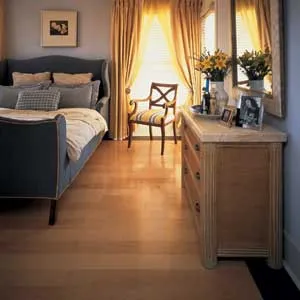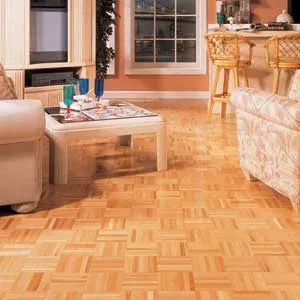The wood look is definitely in. Just consider all those other flooring materials trying to imitate it. While many do a good job, the real McCoy has a distinctive tone, grain, and texture that you can’t duplicate with other materials.
But even real wood flooring now comes in veneer as well as solid forms. The wide range of products and finishes means wood floors can go just about anywhere in your house, including over a concrete slab. We’ll help you navigate the world of wood flooring, covering everything from types and finishes to installation methods and maintenance.

Types of Wood Flooring
Wood flooring comes in several forms, each with its own benefits and considerations. The three main types are solid wood, engineered wood, and parquet flooring. Let’s explore each option to help you determine which best suits your needs.
Solid Wood Flooring

Solid wood flooring is the traditional choice, consisting of planks milled from a single piece of timber. For generations, homes have used solid, 3/4-inch-thick wood flooring, which can last over 100 years with proper care. You can also sand and refinish solid wood floors multiple times.
Red and white oak are the most common species for solid wood flooring, with prices starting at $5 per square foot.* Other popular options include maple ($4–$15 per square foot), hickory ($6–$14 per square foot), and white ash ($6–$14 per square foot). For a more unique look, exotic species such as mahogany, mesquite, and teak are also available.
There are three finishing options: stain flooring to darker hues, use a bleaching stain or light-toned filler treatment, or leave the floor its natural color. After, apply a protective finish.
One limitation of solid wood flooring is its sensitivity to moisture. We don’t recommend it for basements or bathrooms due to its tendency to expand and warp in damp conditions. Additionally, you must nail down solid wood, making it unsuitable for installation directly over concrete slabs without a wood subfloor. Do-it-yourselfers (DIYers) will find this type of flooring more difficult to install than thinner engineered strip flooring.
*Cost data throughout this article via Angi.
Engineered Wood Flooring

Engineered wood flooring offers the look of solid wood with added stability and versatility. It consists of several layers of wood bonded together, with a high-quality wood veneer on top. This construction makes engineered flooring more resistant to moisture and temperature changes than solid wood.
Most engineered flooring comes prefinished, allowing for immediate use after installation. You can install engineered wood flooring in basements and bathrooms, and you can float some over concrete slabs. Engineered flooring is available in a wide range of wood species, thicknesses, and widths, with prices ranging from $4.50–$16 per square foot.
While you can sand and refinish engineered flooring, it’s limited by the thickness of its top layer. You can refinish higher-quality options with a wear layer of at least 1/8 inch thick at least once.
Parquet Flooring

Parquet flooring creates geometric patterns using small pieces of wood. Parquet comes in both solid wood and engineered varieties. This allows for installation in various settings depending on the material.
The most common parquet pattern is the classic basket weave, but more intricate designs are available. While parquet is a striking design element, it may not suit all interior styles and is often more challenging to refinish than traditional plank flooring. Genuine parquet costs between $20 and $45 per square foot, while faux parquet is $7–$15.
Choosing the Right Wood Species
The wood species you choose will impact your floor’s appearance, durability, and cost. Consider factors such as hardness, grain pattern, and color when making your selection.
Wood flooring is also available in different grades, which affect both appearance and price. Made from premium, knot-free boards, select and clear grades offer a more uniform look. Common and number two grades are less expensive and show more variation in grain and color, with occasional tight knots. These lower grades can add character to a floor while being more budget-friendly.
Here are some popular wood species:
- Cherry: Offers a rich color and is best for bedrooms and low-traffic areas of the home.
- Hickory: This offers a timeless look and it’s also a suitable option for high-traffic areas.
- Maple: Prized for its light color and smooth grain, maple is ideal for contemporary interiors. It’s also hard, dense, and very durable.
- Red oak: Provides warm tones and a prominent grain. It’s also durable and has a long lifespan.
- Teak: More expensive than other options. Teak is also very durable and scratch-resistant.
- White ash: This dense hardwood is shock-resistant and capable of absorbing more sound.
- White oak: Offers a slightly cooler hue and finer grain pattern. You can use this flooring both indoors and outdoors.
Exploring Wood Flooring Finishes
The finish on your wood floor not only enhances its appearance but also protects it from wear and tear. There are two main types of finishes: factory-applied and site-applied. Each has its pros and cons.
Factory-Applied Finishes
Many manufacturers offer wood flooring with pre-applied finishes. These highly durable finishes allow for immediate use after installation. Factory-applied finishes typically add around $2 per square foot to the cost of flooring but eliminate the need for on-site finishing, which is messy and time-consuming.
Site-Applied Finishes
Site-applied finishes allow for customization of color and sheen after installation. This option is particularly useful when matching new flooring to existing wood elements in your home. Expect to pay an extra $2–$7 per square foot in labor.
Water-Based vs. Oil-Based Polyurethane
Polyurethane is the most popular finish for site-applied applications. It comes in water-based and oil-based formulations.
Water-based polyurethane dries quickly, allowing for multiple coats in a day. It has a low odor and maintains the wood’s natural color. Oil-based polyurethane takes longer to dry but offers slightly better durability. It tends to amber over time, which can enhance the warmth of the wood.
Installation Methods and Considerations for Wood Flooring
The installation method for your wood flooring depends on the type of flooring, subfloor conditions, and personal preferences. Here are the main installation methods.
- Glue-down installation: Glue-down installation is suitable for both engineered and solid wood flooring. This method is often used when installing wood floors over concrete slabs.
- Floating floor installation: You can install engineered flooring as a floating floor, where planks join together but are not attached to the subfloor. This method is the easiest for DIY installation and works well over various subfloor types.
- Nail-down installation: This traditional method is typically used for solid hardwood flooring. It involves nailing planks directly to a wood subfloor.
Decorative Possibilities for Wood Floors
Wood flooring offers numerous design options. Consider these decorative possibilities.
- Inlays and borders: You can create these decorative elements using contrasting wood species or even incorporate other materials such as stone or metal.
- Patterns and layouts: Experiment with different installation patterns, such as herringbone or diagonal layouts, to add visual interest. Changing direction in larger spaces can define different areas within a room.
- Staining and color options: Staining allows you to customize the color of your wood floor. From light, natural tones to rich, dark hues, staining can dramatically alter the look of your flooring to match your decor.
Maintenance and Care for Wood Floors
Proper maintenance helps preserve the beauty and longevity of your wood floors. Follow these tips to keep your floors looking their best.
Daily Cleaning Tips
- Clean up spills immediately to prevent staining or water damage.
- Sweep or vacuum regularly to remove dirt and debris.
- Use a slightly damp mop for deeper cleaning, avoiding excess water.
Long-Term Preservation Strategies
- Maintain consistent indoor humidity levels to prevent wood expansion and contraction.
- Refinish your floors every 7–10 years or as needed to restore their appearance and protective coating.
- Use furniture pads to prevent scratches.
Wood Flooring Cost Factors
The cost of wood flooring varies widely based on several factors. Understanding these can help you budget effectively for your project.
Wood flooring installation costs $2,474–$7,031, or between $6 and $12 per square foot for labor and materials, depending on the wood species, grade, and whether it’s solid or engineered. Exotic woods and premium grades typically command higher prices.
While wood flooring may have a higher upfront cost compared to some alternatives, its longevity and ability to be refinished make it a valuable long-term investment that can increase your home’s resale value.
Shopping Smart for Wood Flooring

Lumberyards, home centers, and flooring dealers all sell wood floors. However, dealers that sell carpeting, vinyl flooring, and tile will probably offer a broader selection of wood flooring than lumberyards and home centers do. You’ll also be able to get quotes on installation prices for different types of floors from dealers.
Wood flooring often comes with warranties and guarantees. If you’re using the retailer’s installation services, look for coverage on finish wear, wood defects, and installation issues.
When shopping, ask about:
- Acclimation requirements before installation
- Recommended installation methods
- The wood’s origin and sustainability practices
- Warranty coverage and terms
Wood Flooring Common Concerns
Wood flooring comes with some common concerns that you should be aware of and prepared to address.
- Gaps and warping: Gaps and warping can occur due to seasonal changes in humidity. Choosing engineered wood or narrower solid wood planks can help minimize these issues.
- Height differences between rooms: When installing wood flooring, consider potential height differences with adjacent rooms. Transition strips or thinner flooring options can help manage these differences.
- Moisture issues: Proper moisture management is crucial for wood flooring. To prevent issues, use moisture barriers when installing over concrete and maintain consistent indoor humidity levels.
DIY vs. Professional Wood Flooring Installation
Deciding whether to install your wood flooring yourself or hire a professional depends on your skills, tools, and the complexity of the project. DIY installation requires specialized tools such as a flooring nailer, saw, and moisture meter. You’ll also need skills in measuring, cutting, and potentially finishing wood.
Professional installers bring expertise and efficiency to the job and often provide warranties on their work. This is particularly valuable for complex installations or when working with high-end materials. Improper installation can cause the floors to warp, crack, split, bow, or shrink over time.
Our Conclusion
Wood flooring remains a popular choice for homeowners due to its timeless appeal, durability, and ability to increase home value. With a wide range of options available, from traditional solid hardwood to versatile engineered products, there’s a wood flooring solution for every style and budget. When choosing wood flooring, consider factors such as the room’s location, subfloor conditions, and your long-term maintenance expectations.
Where to find it:
Manufacturers:
Anderson Hardwood Floors
384 Torrington Rd.
Clinton, SC 29325
800/252-4186.
Bruce Hardwood Floors
Box 308
Mount Olive, NJ
800/722-4647
Firebird Industries
Box 10457
Jefferson, LA 70181-0457
800-634-3829
Harris-Tarkett
Johnson City, TN 37605-0300
800/842-7816
Hartco Flooring Co.
900 Gay St.
Knoxville, TN 37841
423/544-0767
Mannington Wood Floors
1327 Lincoln Dr.
Highpoint, NC 27260
800/252-4202
International Hardwood Floors
7400 Edmund St.
Philadelphia, PA 19136
215/624-4566
Piedmont Hardwood Flooring
Box 3070
Macon, GA 31205
912/781-0155
Specialty Floors:
Br-111 Imports & Exports
9435-K Washington Blvd.
Laurel, MD 20723
800/525-2711
Goodwin Heart Pine
106 SW. 109th Pl.
Micanopy, FL 32667
800/336-3118
Historic Floors of Oshkosh
911 E. Main St.
Winneconne, WI 54986
920/582-9977
Trade Associations:
Maple Flooring Manufacturing Association
60 Revere Dr., Suite 500
Northbrook, IL 60062
312/480-9138
National Oak Flooring Manufacturers Association
Box 3009
Memphis, TN 38173-0009
901/526-5016
National Wood Flooring Association
1688 Westwoods Business Park
Ellisville, MO 63021-4522
800/422-4556
